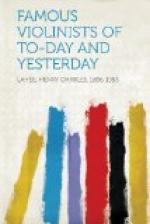He left Dresden and went to Prague, where he entered the service of Count Kinsky. In 1736 he again visited London, but met with little success, owing to the fact that Geminiani had ingratiated himself with the public. In 1847 Veracini returned to Pisa.
Veracini has been sometimes ranked with Tartini as a performer. He was also a composer of ability. In making a comparison of him with Geminiani it has been said that Geminiani was the spirit of Corelli much diluted, while Veracini was the essence of the great master fortified with l’eau de vie.
Veracini was conceited and vainglorious, and these traits of his character have given rise to a number of rather inconsequential stories. He was a most excellent conductor of orchestra, and Doctor Burney mentions having heard him lead a band in such a bold and masterly manner as he had never before witnessed. Soon after leaving London Veracini was shipwrecked, and lost his two Stainer violins, which he stated were the best in the world. These instruments he named St. Peter and St. Paul.
The name of Giuseppe Tartini will ever live as that of one of the greatest performers on, and composers for, the violin. Born at Pirano, in 1692, his career may be said to have commenced with the eighteenth century. He was not only one of the greatest violinists of all time, and an eminent composer, but he was a scientific writer on musical physics, and was the first to discover the fact that, in playing double stops, their accuracy can be determined by the production of a third sound. He also wrote a little work on the execution and employment of the various kinds of shakes, mordents, cadenzas, etc., according to the usage of the classical Italian school.
Tartini’s father, who was an elected Nobile of Parenzo, being a pious Church benefactor, intended his son for the Church, and sent him to an ecclesiastical school at Capo d’Istria, where he received his first instruction in music. Finding himself very much averse to an ecclesiastical career, Tartini entered the University of Padua to study law, but this also proved distasteful to him. He was a youth of highly impulsive temperament, and became so much enamoured of the art of fencing that he, at one time, seriously contemplated adopting it as a profession. This very impulsive nature caused him to fall in love with a niece of the Archbishop of Padua, to whom he was secretly married before he was twenty years of age.
The news of this marriage caused Tartini’s parents to withdraw their support from him, and it so enraged the archbishop that the bridegroom was obliged to fly from Padua. After some wanderings he was received into a monastery at Assisi, of which a relative was an inmate. Here he resumed his musical studies, but though he learned composition of Padre Boemo, the organist of the monastery, he was his own teacher on the violin. The influence of the quiet monastic life caused a complete change in his character, and he acquired the modesty of manner and serenity of mind for which he was noted later in life.




